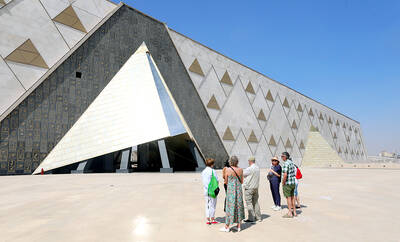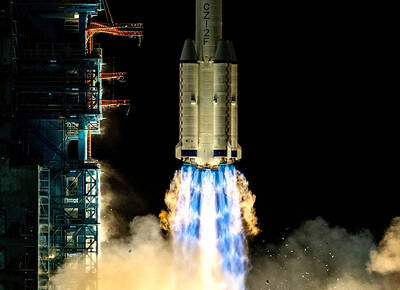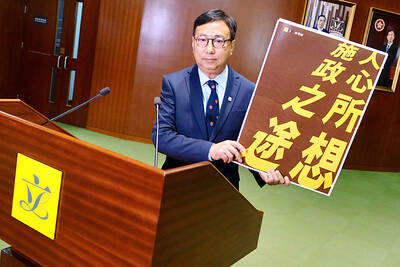A top Iranian official abruptly canceled a meeting scheduled for yesterday with the head of the International Atomic Energy Agency (IAEA), dealing a blow to IAEA efforts to investigate alleged attempts by Tehran to make nuclear arms, an agency official said.
The IAEA official, confirming Iranian media reports that the meeting was off, said that no reason had been given on Sunday for the cancellation.
But a senior diplomat had told the AP that IAEA head Mohamed ElBaradei likely planned to use the meeting with Gholam Reza Aghazadeh, the head of Iran’s nuclear program, to renew a request for more information on allegations Tehran had tried to make atomic arms.
Both the official and the diplomat demanded anonymity because they were not authorized to comment by name on the Iranian nuclear issue.
The diplomat, who follows IAEA attempts to clear up suspicions about Iran’s nuclear activities, said the meeting also was likely to have focused on Iran’s latest show of defiance of UN Security Council demands to suspend uranium enrichment.
Last week Iranian President Mahmoud Ahmadinejad announced that his nation was installing thousands of new uranium-enriching centrifuges and testing a much faster version of the device.
Ahmadinejad said scientists were putting 6,000 new centrifuges into place, about twice the current number, and testing a new type that works five times faster.
That would represent a major expansion of uranium enrichment — a process that can produce fuel for a nuclear reactor.
Still, others suggested the claims may be exaggerated.
US Secretary of State Condoleezza Rice cautioned the claim could not be immediately substantiated, and diplomats close to the IAEA said Iran has exaggerated its progress and experienced problems operating the 3,000 centrifuges already in place. One diplomat said Ahmadinejad’s claims of a more advanced centrifuge appeared to allude to a type known as the IR-2, which the agency and Iran said months ago that Iran had begun testing.
The IR-2 is believed to be two-to-three times faster than the centrifuges currently in use, and his claim that the new machine was five times as quick added to the diplomats’ skepticism.
In the enrichment process, uranium gas is pumped into a series of centrifuges called “cascades.” The gas is spun at supersonic speeds to remove impurities. Enriching at a low level produces nuclear fuel, but at a higher level it can produce the material for a warhead. Iran says it is only interested in the process to generate nuclear power and plans to move toward large-scale uranium enrichment that ultimately will involve 54,000 centrifuges.
The canceled meeting was also considered the first test of whether Iran will truly continue to stonewall the IAEA, the UN nuclear watchdog, in its attempt to investigate the alleged military programs after saying earlier this year that such allegations were fabricated.
Iran has denied ever trying to make such weapons. But US intelligence agencies say Tehran experimented with such programs until 2003, and other countries believe it continued past that date.
Suspected weapons-related work outlined in a February presentation to the IAEA’s 35-nation board and IAEA reports preceding it include: Uranium conversion linked to high explosives testing and designs of a missile re-entry vehicle, all apparently interconnected through involvement of officials and institutions; procurement of so-called “dual use” equipment and experiments that could be used in both civilian and military nuclear programs; Iran’s possession of a 15-page document outlining how to form uranium metal into the shape of a warhead.
Iran is under three sets of Security Council sanctions for its refusal to suspend enrichment and meet other council demands designed to ease fears its civilian nuclear program is a cover for attempts to make atomic arms.

With much pomp and circumstance, Cairo is today to inaugurate the long-awaited Grand Egyptian Museum (GEM), widely presented as the crowning jewel on authorities’ efforts to overhaul the country’s vital tourism industry. With a panoramic view of the Giza pyramids plateau, the museum houses thousands of artifacts spanning more than 5,000 years of Egyptian antiquity at a whopping cost of more than US$1 billion. More than two decades in the making, the ultra-modern museum anticipates 5 million visitors annually, with never-before-seen relics on display. In the run-up to the grand opening, Egyptian media and official statements have hailed the “historic moment,” describing the

‘CHILD PORNOGRAPHY’: The doll on Shein’s Web site measure about 80cm in height, and it was holding a teddy bear in a photo published by a daily newspaper France’s anti-fraud unit on Saturday said it had reported Asian e-commerce giant Shein (希音) for selling what it described as “sex dolls with a childlike appearance.” The French Directorate General for Competition, Consumer Affairs and Fraud Control (DGCCRF) said in a statement that the “description and categorization” of the items on Shein’s Web site “make it difficult to doubt the child pornography nature of the content.” Shortly after the statement, Shein announced that the dolls in question had been withdrawn from its platform and that it had launched an internal inquiry. On its Web site, Le Parisien daily published a

China’s Shenzhou-20 crewed spacecraft has delayed its return mission to Earth after the vessel was possibly hit by tiny bits of space debris, the country’s human spaceflight agency said yesterday, an unusual situation that could disrupt the operation of the country’s space station Tiangong. An impact analysis and risk assessment are underway, the China Manned Space Agency (CMSA) said in a statement, without providing a new schedule for the return mission, which was originally set to land in northern China yesterday. The delay highlights the danger to space travel posed by increasing amounts of debris, such as discarded launch vehicles or vessel

RUBBER STAMP? The latest legislative session was the most productive in the number of bills passed, but critics attributed it to a lack of dissenting voices On their last day at work, Hong Kong’s lawmakers — the first batch chosen under Beijing’s mantra of “patriots administering Hong Kong” — posed for group pictures, celebrating a job well done after four years of opposition-free politics. However, despite their smiles, about one-third of the Legislative Council will not seek another term in next month’s election, with the self-described non-establishment figure Tik Chi-yuen (狄志遠) being among those bowing out. “It used to be that [the legislature] had the benefit of free expression... Now it is more uniform. There are multiple voices, but they are not diverse enough,” Tik said, comparing it